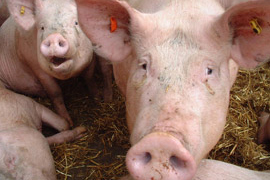Research: Living near intensive farms a health risk

Research carried out in the Netherlands, Germany and the US raises new concerns about the potential health effects of intensive livestock farms for neighbouring residents. The findings raise serious public-health questions for planners considering proposals for a large scale intensive farm with 25,000 pigs near Foston in Derbyshire.
Dutch scientists found that the DNA of livestock-associated MRSA strain ST398 is found more frequently and in higher concentrations in the air in a radius of 1 km around intensive pig and poultry farms. Scientists only tested for MRSA, but believe other types of antibiotic resistant bacteria might also be emitted from intensive livestock farms. The Soil Association is calling for research into the public-health risks of these emissions [1][2].
Transmission of MRSA ST398 to humans is known to occur most frequently for people in direct contact with farm animals. However, a second recent Dutch study found that people living in livestock-dense areas who don’t have direct contact with farm animals are also at increased risk of being carriers of MRSA ST398 [3].
Peter Melchett, Soil Association Policy Director, said; “Scientists already knew that people working on intensive farms had increased health risks such as reduced lung function and exposure to MRSA ST398, but they are now finding evidence that people living near these farms could be affected too. The greater the numbers of animals being kept, the greater these risks are likely to be. It is wrong for people to be exposed to huge numbers of animals by building large scale intensive farms near where they live. The Soil Association urges Derbyshire County Council to consider these new findings when making the decision on the planning application for the intensive pig farm near Foston.”
Further to these findings, a European study of MRSA ST398 prevalence in 17 countries found that proximity to, without direct contact with pigs and veal calves may be a risk factor for acquiring the bacteria [4]. The Dutch scientists said their own findings ‘provide a warning that where one lives may play a critical role in one’s risk of disease’ [3][5].
Just as worryingly, a large German study examined 7,000 people and found that those living within 500m of intensive livestock farms had a significantly reduced lung function (their forced expiratory volume in one second was reduced by 8%) [6]. An American study in North Carolina similarly found reduced lung function in residents sitting outside their homes for 10 minutes twice a day. Increased concentrations of endotoxins (bacterial toxins which are found in greater concentrations near intensive farms) were also associated with more sore throats, chest tightness and nausea [7][8].
Peter Melchett added; “Pig farmers are caught between a rock and hard place, with some feeling high feed costs and cheap imports make trying to achieve ever greater economies of scale their only option. But very large scale, indoor pig farms aren’t the answer here in Britain – with research in countries where they have been established now revealing their animal and human health problems. We need to work together to solve the problems that make it hard to make a living keeping pigs outdoors, on a scale that fits with the communities living nearby. The recent horse meat scandals give all of us involved in UK farming the opportunity to champion high standards of production and short supply chains.”







